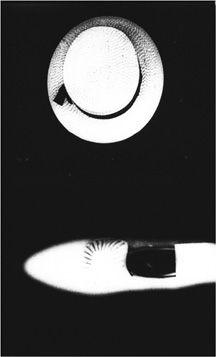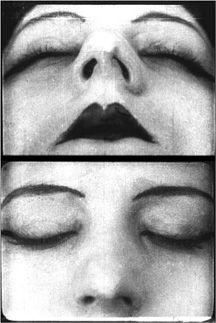B0041VYHGW EBOK (153 page)
Authors: David Bordwell,Kristin Thompson


10.73 Shapes create graphic contrast in
Ballet mécanique.
After the shoe-and-hat duet, more shots of the woman follow, again cut to make her face execute a series of artificial shifts. Two slightly different views of a woman’s face quickly alternate, inducing us to see the head as nodding
(
10.74
).
Finally, quick shots of bottles make them seem to change position in a dancelike rhythm. Here, where the mechanical ballet becomes most explicit, the film draws together elements from its beginning, and from the previous segment, where the recapitulation of the earlier segments had begun. Segment 7 avoids motifs from the center of the film—
segments 3
–5—and thus gives us a sense both that the film is continuing to develop and that it is coming full circle.

10.74 In
Ballet mécanique,
slight changes of composition make a face “nod.”
The final segment makes this return more obvious by showing us the Chaplin figure again. Now its movements are even less human, and at the end, most of its parts seem to fall away, leaving the head alone on the screen. The spinning head may remind us of the woman’s profile (
10.68
) seen earlier. But the film is not quite over. Its last shot brings back the woman from the swing in
segment 1
, now standing in the same garden smelling a flower and looking around. Seen in another context, her gestures might seem ordinary to us
(
10.75
).
But by now, as Hollis Frampton puts it (
p. 366
), the film has trained us sufficiently for us to make the connection between this shot and what has preceded it. Our expectations have been so strongly geared to seeing rhythmic, mechanical movement that we will probably see her smiles and head gestures as
un
natural, like other motifs we have seen in the film. Léger and Murphy end their abstract film by emphasizing how much they have altered our perception of ordinary objects and people.

10.75 The final shot of
Ballet mécanique.
Many experimental films draw on a poetic series of transitions that create what we may term
associational form
. Associational formal systems suggest ideas and expressive qualities by grouping images that may not have any immediate logical connection. But the very fact that the images and sounds are juxtaposed prods us to look for some connection—an
association
that binds them together.
Godfrey Reggio’s
Koyaanisqatsi
is a clear example of associational form. The film is built out of shots of widely different things—airplanes and buttes, subways and clouds, rockets and pedestrians. At one point, rows of frankfurters are pumped out of a machine and fed onto an assembly line. Reggio then cuts to fast-motion shots of commuters riding escalators. The juxtaposition has no narrative connection, and the pictorial qualities are not as strongly stressed as they would be in
Ballet mécanique.
Instead, the shots evoke the idea of impersonal, routine sameness, perhaps suggesting that modern life makes people into standardized units. The filmmaker has created an association among unlike things.
Koyaanisqatsi
illustrates the unique qualities of associational form. The film surely presents a process, but it does not tell a story in the manner of narrative filmmaking. It offers no continuing characters, no specific causal connections, and no temporal order among the scenes. The film has a point, perhaps several, but it doesn’t attempt to persuade us of it through an argument, giving reasons and offering evidence to lead us to a conclusion. There is no voice-over narrator as in
The River
to define problems and marshall evidence. Nor does the film explore a clear-cut set of categories. It centers on majestic nature and destructive technology, very loose and open-ended ideas. But
Koyaanisqatsi
is not purely a pictorial exercise either, in the manner of abstract form. The connections we make among its images sometimes involve visual qualities, but these qualities are associated with broader concepts and emotions.
This process is somewhat comparable to the techniques of metaphor and simile used in lyric poetry. When the poet Robert Burns says, “My love is like a red, red rose,” we do not leap to the conclusion that his love is prickly to the touch, bright red, or vulnerable to aphids. Rather, we look for the possible conceptual links: her beauty is the most likely reason for the comparison.
A similar process goes on in associational films. Here the imagery and the metaphorical connections that poetry conveys through language are presented in a more direct fashion. A filmmaker could film a woman he loved in a garden and suggest by visual juxtaposition that she is like the flowers that surround her. (Indeed, this might be an implicit meaning that viewers could assign to
Ballet mécanique
’s last shot, if it were taken out of context.) Some critics would consider associational form the closest that cinema can come to lyric poetry.
The imagery used in associational form may range from the conventional to the strikingly original, and the conceptual connections can be readily apparent or downright mystifying. These possibilities are not necessarily linked: a highly original juxtaposition might have an obvious emotional or conceptual implication. Again, poetry offers examples. Many religious, patriotic, romantic, and laudatory poems use strings of images to create an expressive tone. In “America the Beautiful,” the images of “spacious skies,” “purple mountains’ majesty,” and “fruited plain” add up to suggest the patriotic fervor expressed in the chorus, “God shed his grace on thee.”
Another poem might be more elusive in its effect, giving us less explicit statements of the associative qualities of its imagery. The Japanese poetic form called
haiku
usually juxtaposes two images in a brief three-line form, in order to create an immediate emotion in the reader. Here, for example, is a haiku by the Japanese poet Kakei:
The eleventh moon—
Storks listlessly
Standing in a row
Kakei’s images are somewhat cryptic, and the purpose for connecting them is somewhat mysterious. Yet, if we are willing to fill in with our imaginations, as one is supposed to do with haiku, the effect should be a mood, evoking autumnal stillness with perhaps a trace of melancholy. This tone isn’t present in either the moon or the storks but results from the juxtaposition of the two images.
So far we have looked at associational form working at a fairly small-scale level: the side-by-side juxtaposition of images. Associational form also creates larger-scale patterns that can organize an entire film. Yet because associational formal systems are unlimited in their subjects and means of organization, it’s impossible to define a conventional set of parts into which an associational film will fall. Some films will show us a series of amusing images, while others may offer us frightening ones. Still, we can make a start at understanding associational form by noticing that it usually accords with a few general principles.
First, the filmmaker typically groups images together in larger sets, each of which creates a distinct, unified part of the film. Each group of images can then contrast with other groups of images. This principle of grouping is also seen in abstract form, as our
Ballet mécanique
analysis shows. Second, as in other types of form, the film uses repeated motifs to reinforce associational connections. Third, associational form strongly invites interpretation, the assigning of general meanings to the film, as in the environmentalist implications of
Koyaanisqatsi.
The associational small-scale connections, the distinct large-scale parts, the repeated motifs, the cues for interpretation—all these factors indicate that associational organization puts demands on the viewer. This is why so many filmmakers seeking to push the boundaries of form use associational patterns. Although associational form may use striking, original, even puzzling, juxtapositions, it may still elicit a fairly familiar emotion or idea. The explicit point of
Koyaanisqatsi
is not particularly subtle or novel. Here, as in many associational films, the purpose is to make a familiar emotion or concept vivid by means of new imagery and fresh juxtapositions.
Other associational films are more complex and evocative. The filmmaker will not necessarily give us obvious cues to the appropriate expressive qualities or concepts. He or she may simply create a series of unusual and striking combinations and leave it up to us to tease out their relations. Kenneth Anger’s
Scorpio Rising,
for instance, explicitly associates motorcycle gangs with traditional religious groups and with Nazi violence, but it also suggests, more elusively, that gang regalia and rituals have homoerotic aspects. Like other sorts of film form, associational form can offer implicit as well as more explicit meanings.
A Movie
Bruce Conner’s film
A Movie
illustrates how associational form can confront us with evocative and mysterious juxtapositions, yet can at the same time create a coherent film that has an intense impact on the viewer.
Conner made
A Movie,
his first film, in 1958. Like Léger, he worked in the visual and plastic arts and was noted for his
assemblage
pieces—collages built up of miscellaneous found objects. Conner took a comparable approach to filmmaking. He typically used footage from old newsreels, Hollywood movies, soft-core pornography, and the like. By working in the found-footage genre, Conner juxtaposed two shots from widely different sources. When we see the two shots together, we strive to find some connection between them. From a series of juxtapositions, our activity can create an overall emotion or concept.
A Movie
uses a musical accompaniment that helps establish these emotions and ideas. As with the images, Conner chose music that already existed: three portions of Respighi’s well-known tone poem
The Pines of Rome.
The music is important to the film’s form, since it has distinct sections. Moreover, the atmosphere of each segment is different, corresponding to the music. The beginning of what we’ll identify as
segment 3
, showing women carrying totems, the crash of the Hindenburg dirigible, and some daring acrobats, gains its ominous effect largely from the eerie score. Likewise, the driving music accompanying
segment 4
sweeps a string of horrendous disasters into one plunging apocalyptic rush. Conner’s use of
The Pines of Rome
shows vividly how associational form can create both general ideas and strong emotional effects.
We can break
A Movie
into four large-scale segments. Each segment consists of related images, marked off from other segments by a shared expressive idea and by a distinct musical accompaniment.
